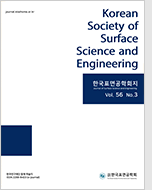
- Past Issues
- e-Submission
-

2021 Impact Factor 1.766
5-Year Impact Factor 1.674
Editorial Office
- +82-2-563-0935
- +82-2-558-2230
- submission@kssse.or.kr
- https://www.kssse.or.kr/

2021 Impact Factor 1.766
5-Year Impact Factor 1.674
The Korean Society of Surface Science and Engineering 2024;57(3):201-207. Published online: Jul, 8, 2024
DOI : 10.5695/JSSE.2024.57.3.201
This study compared the chemical resistance properties according to various sealing treatment methods for the anode film formed during the anodization process of Al6061 alloy. Al6061 aluminum was used in four different sealing treatment methods: boiling water sealing, lithium sealing, nickel sealing, and pressurized sealing, and each sample was evaluated for corrosion resistance through a 5% HCl bubble test and the microstructure was observed through a scanning electron microscope(SEM). According to the results, corrosion resistance increased as time and temperature increased in all sealing treatment methods. Relatively, corrosion resistance was high in the order of boiling water sealing, lithium sealing, nickel sealing, and pressure sealing, and the best corrosion resistance was found in pressure sealing. These research results can be helpful in selecting a process necessary to improve the efficiency and performance of anodizing process in the industrial field using aluminum alloys.
Keywords Anodizing; Oxide film; Al6061 alloy; Sulfuric acid anodizing; Sealing; Acid resistance; Hydrogen Chloride bubble stream.